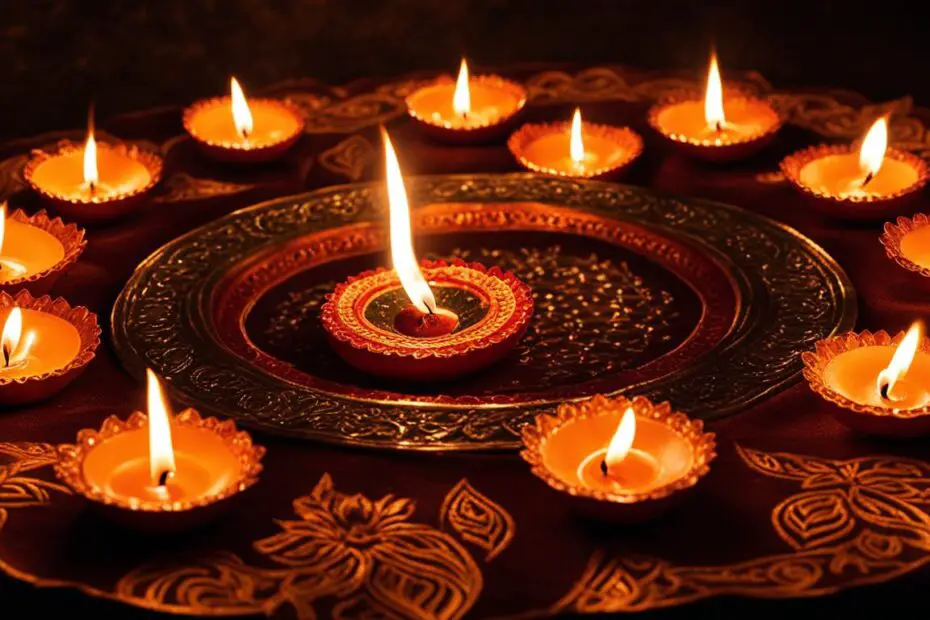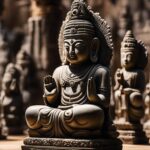Diyas, also known as oil lamps, hold significant cultural and spiritual importance in Hindu festivals such as Diwali. These traditional lamps are made of clay and filled with ghee or oil. They symbolize the triumph of light over darkness, inviting positive energy and dispelling negativity. Diyas are typically placed at the entrance of homes or in every room, creating an inviting ambiance and illuminating the path to inner radiance.
Key Takeaways:
- Diyas, or oil lamps, are prominent in Hindu festivals like Diwali.
- They represent the victory of light over darkness and symbolize positive energy.
- Diyas are made of clay and filled with ghee or oil.
- They create an inviting ambiance and guide individuals towards inner radiance.
- Diyas have cultural significance and are placed at the entrance of homes or in every room.
The Symbolism and Significance of Diyas
Diyas hold deep symbolism and significance in Hindu festivals, especially during Diwali. These oil lamps represent the triumph of light over darkness and the victory of good over evil. Lighting diyas is believed to dispel negativity and invite positive energy into homes and lives.
The warmth and glow of the diyas symbolize the illumination of the path to inner wisdom and spiritual enlightenment. By lighting these lamps, individuals seek to awaken knowledge and dispel ignorance, fostering personal growth and a deeper connection with the divine.
Diyas also hold cultural significance, representing hospitality and the welcoming of guests. Placing diyas at the entrance of homes or in every room during Diwali not only creates an inviting ambiance but also expresses gratitude and seeks blessings from deities and ancestors.
“The act of lighting diyas during Diwali is a symbolic gesture of inviting positivity, joy, and prosperity into one’s life. It represents the purification of the surroundings and the creation of a harmonious environment conducive to spiritual growth.”
Throughout different Hindu sects, the symbolism and usage of diyas remain consistent. However, there may be variations in their materials, shapes, and decorations based on regional customs and artistic traditions. Some prefer brass diyas, while others opt for clay or terracotta ones. The patterns and motifs used to adorn diyas may also differ, adding to the diversity and beauty of these traditional lamps.
Over time, diyas have evolved in terms of materials and designs. Traditional clay diyas have paved the way for modern variations made of brass, ceramic, and even decorative glass. While new designs incorporate intricate patterns and contemporary elements, the traditional ones continue to hold a special place, preserving cultural heritage and embodying the essence of Diwali.
Variations Among Sects: Diyas in Different Hindu Traditions
Within the diverse tapestry of Hindu traditions, variations in the design and use of diyas, or oil lamps, can be observed. Different sects across India have specific preferences when it comes to the material, shape, and decoration of their diyas. These variations add richness and depth to the cultural significance of these lamps.
Regional Differences in Diya Designs
One noticeable variation among sects is the choice of material for diyas. In some regions, brass diyas are popular due to their durability and aesthetic appeal. The intricate metalwork and timeless elegance of brass add a touch of sophistication to the celebrations. On the other hand, clay or terracotta diyas are preferred in regions where traditional craftsmanship is highly valued. These diyas, often handcrafted by skilled artisans, carry the charm and authenticity of centuries-old traditions.
Symbolic Motifs and Patterns
Regional customs and artistic traditions also influence the motifs and patterns used to decorate diyas. For example, in certain sects, diyas adorned with peacock designs are considered auspicious as the peacock symbolizes beauty and abundance. In other regions, diyas embellished with lotus motifs are favored, as the lotus represents purity and spiritual enlightenment. These variations in design not only reflect the aesthetic preferences of different sects but also deepen the spiritual symbolism associated with the lamps.
“The diversity of diya designs across Hindu sects is a testament to the rich tapestry of India’s cultural heritage. Each variation holds its own unique beauty and adds to the collective vibrancy of Diwali celebrations.”
– Dr. Rama Roy, Cultural Anthropologist
Customs Passed Down Through Generations
These variations among sects in the design and use of diyas are a result of customs and traditions passed down through generations. They not only reflect the cultural diversity of India but also serve as a means of preserving and honoring ancient customs. The significance of these variations goes beyond aesthetic preferences, as they symbolize the deep-rooted spiritual beliefs and values cherished by each sect.
The variations in diya designs among Hindu sects showcase the richness of India’s cultural heritage and the diversity of spiritual traditions. From the choice of materials to the motifs and patterns used for decoration, these variations add depth and meaning to the symbolism of diyas in Diwali celebrations.
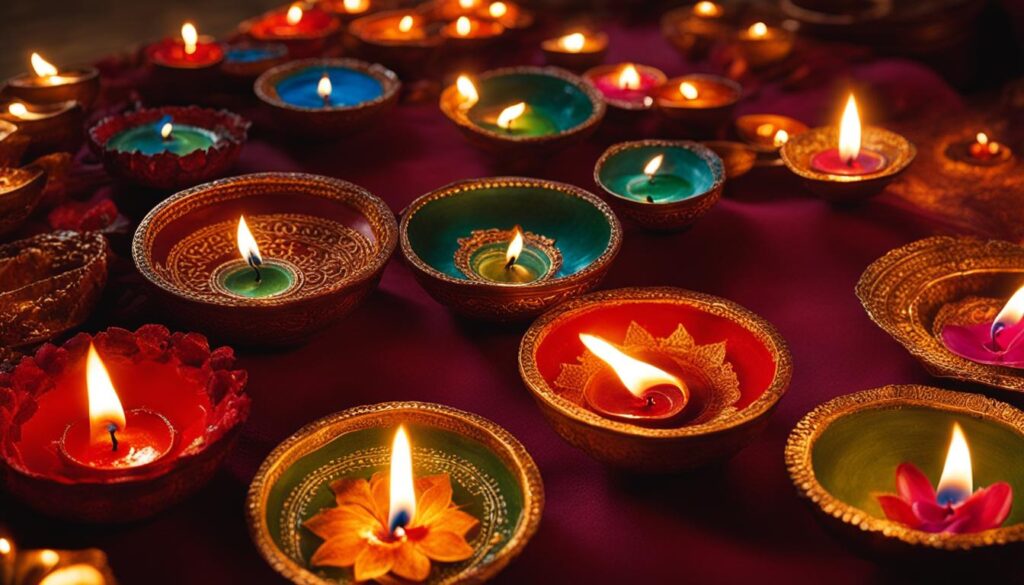
The Evolution of Diya Materials and Designs Over Time
Throughout history, the materials and designs of diyas have evolved, reflecting the changing tastes and preferences of individuals celebrating Diwali. Traditional diyas were primarily made of clay, symbolizing the connection with nature and the humble origins of the festival. However, with advancements in technology and access to different materials, the range of diya options has expanded.
“The use of clay diyas during Diwali is deeply rooted in our cultural heritage. They not only provide a warm, soothing glow but also remind us of our connection to the earth. However, in recent years, we have seen a shift towards using alternative materials like brass, ceramic, and even decorative glass. These modern diya designs offer a unique blend of tradition and contemporary aesthetics, allowing individuals to express their personal style during the festival.”
While traditional clay diyas continue to hold a special place in Diwali celebrations, the availability of materials such as brass has led to the emergence of brass diyas. Brass diyas are known for their durability and lustrous appearance, adding a touch of elegance to the festivities. These diya designs often feature intricate patterns and motifs, showcasing the skilled craftsmanship associated with brasswork.
The Evolution of Diya Designs
Designs have also evolved over time, with artisans exploring innovative patterns and decorations for diyas. Traditional designs, such as lotus-shaped diyas or those adorned with peacock motifs, still remain popular. However, contemporary designs have introduced new elements that appeal to a wider audience.
The incorporation of crystals, gemstones, and colorful accents has given rise to an array of decorative diyas that catch the eye and enhance the festive ambiance. These embellishments add a touch of glamour and opulence while staying true to the underlying symbolism of diyas.
| Traditional Diya Materials | Modern Diya Materials |
|---|---|
| Clay | Brass |
| Terracotta | Ceramic |
| Glass |
As individuals seek diya designs that align with their personal style and preferences, the market has seen a rise in customized and handcrafted options. Artisans and designers now create unique diya lamps that showcase their creativity and skill. These one-of-a-kind diyas not only add beauty to Diwali decorations but also serve as cherished keepsakes, passed down through generations, and preserving the rich cultural heritage associated with the festival.
https://www.youtube.com/watch?v=tusVXl8yots
In conclusion, the evolution of diya materials and designs over time has allowed individuals to express their creativity and personal style while maintaining the sacred symbolism of the lamps. From traditional clay diyas to modern brass and decorative glass options, there is a wide range of diya choices available during Diwali celebrations. Whether one chooses to embrace the roots of the festival with clay diyas or adds a contemporary twist with trendy designs, the essence of Diwali remains the same – celebrating the triumph of light over darkness and illuminating the path to inner radiance.
Lesser-Known Diya Varieties: Exploring Unique and Uncommon Oil Lamps
In addition to the commonly known clay and brass diyas, there are lesser-known varieties that offer a unique twist to the traditional oil lamps. These unconventional diyas add a touch of exclusivity and charm to Diwali celebrations. Let’s explore some of these lesser-known diya types:
Table: Unique and Uncommon Diya Varieties
| Diya Variety | Description |
|---|---|
| Handmade Diya Lamps | These diyas are crafted by skilled artisans, showcasing intricate craftsmanship and artistic flair. Each handmade diya lamp is a work of art, adding a touch of elegance and uniqueness to Diwali decorations. |
| Antique Diya Lamps | Antique diya lamps are sought after by collectors and enthusiasts. These rare oil lamps are often made of exquisite materials or feature vintage designs, becoming cherished heirlooms that have stood the test of time. |
| Crystal Diyas | Crystal diyas bring a touch of modernity to Diwali celebrations. These elegant oil lamps are made of sparkling crystals, reflecting the light in a mesmerizing manner and adding a contemporary twist to tradition. |
These and other unique diya varieties provide a delightful departure from the traditional clay and brass lamps, allowing individuals to express their creativity and embrace unconventional designs. Whether it’s a handcrafted diya lamp, an antique treasure, or a modern crystal piece, these lesser-known diyas bring a sense of novelty and individuality to the festival of lights.
Spiritual Significance of Lighting Diyas during Diwali
Lighting diyas during Diwali holds profound spiritual significance. It represents the illumination of one’s inner self, the awakening of knowledge, and the dispelling of ignorance. The act of lighting diyas is a symbolic gesture of inviting positivity, joy, and prosperity into one’s life. It is believed to purify the surroundings and create a harmonious environment conducive to spiritual growth. Lighting diyas is also a way to express gratitude and seek blessings from deities and ancestors.
The flickering flame of the diya is seen as a representation of the divine presence within every individual. It is a reminder to cultivate inner light and seek enlightenment. As the darkness is dispersed by the glow of the diya, it is believed that negative energies and obstacles are also eliminated, making space for positivity and abundance.
In addition to its symbolic meaning, lighting diyas during Diwali is also a way to commemorate significant events in Hindu mythology. It is said that Lord Rama, after his triumphant return to Ayodhya, was welcomed with rows of brightly lit diyas. This tradition is upheld to honor Lord Rama’s victory over the forces of darkness and to celebrate his righteous path.
“The flickering flame of the diya is seen as a representation of the divine presence within every individual.”
Creating a Festive Ambiance with Decorative Diyas
Decorative diyas play a crucial role in creating a festive ambiance during Diwali. These beautifully adorned oil lamps add charm and elegance to homes and temples. Diyas may be embellished with colorful designs, patterns, or gemstones, enhancing their visual appeal. Placing these decorative diyas at strategic locations in and around the house creates a warm and inviting atmosphere, elevating the overall festive experience.
“The warm glow of diyas not only illuminates the physical space but also radiates positive energy that uplifts the spirits of those celebrating Diwali.”
Decorative diyas come in a variety of styles and designs, catering to different aesthetic preferences. From intricately carved brass diyas to hand-painted clay diyas, there are options to suit every taste. Some decorative diyas also incorporate modern elements, blending traditional craftsmanship with contemporary flair.
Whether placed on doorsteps, windowsills, or as centerpieces on Diwali decorations, decorative diyas create a mesmerizing visual spectacle that enhances the festive atmosphere. Their soft, flickering glow adds an ethereal charm to the surroundings, instilling a sense of joy and celebration.
By choosing decorative diyas, individuals can transform their homes into enchanting spaces that reflect the spirit of Diwali, fostering a vibrant and joyful environment for family, friends, and loved ones to come together and celebrate.

Handmade Diyas: Embracing Artistry and Tradition
Handmade diyas are a testament to the exquisite artistry and craftsmanship that goes into their creation. Skilled artisans employ traditional techniques that have been passed down through generations, ensuring that each diya is a work of art. These unique oil lamps are not only functional but also serve as cultural artifacts, preserving the rich heritage and promoting the importance of artisanal skills.
The process of traditional diya making involves meticulous attention to detail. Artisans shape the clay or mold the metal into the desired form, carefully sculpting intricate designs and patterns. The diyas are then dried, fired, and meticulously painted or embellished with decorative elements. The result is a beautifully crafted diya that showcases the artist’s skill and love for their craft.
By choosing handmade diyas, individuals not only add a touch of elegance to their Diwali celebrations but also support local artisans. These unique pieces contribute to the preservation of traditional art forms and help sustain the livelihoods of these talented craftsmen. Embracing handmade diyas is a way to honor the artistry and tradition behind these timeless oil lamps.
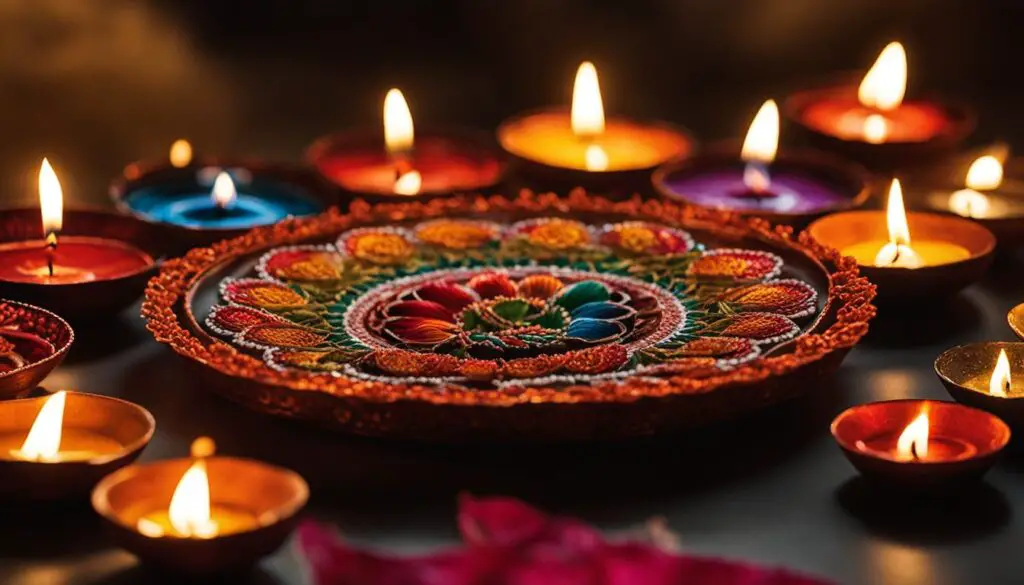
Clay Diyas: Embracing Tradition and Sustainability
Clay diyas, also known as clay oil lamps, are a traditional and eco-friendly option for lighting during Diwali. These diyas are made from natural clay, which is a sustainable material that does not harm the environment when disposed of. Choosing clay diyas not only embraces the rich tradition and cultural heritage associated with Diwali but also promotes a more sustainable way of celebrating this festival of lights.
Clay diyas symbolize the connection between humans and nature. The earthy texture and natural color of clay bring a sense of grounding and spirituality to the festivities. Lighting a clay diya is believed to invite positive energy and drive away negativity, creating a harmonious and peaceful environment.
These sustainable diya options come in various shapes and sizes, allowing individuals to personalize their Diwali decorations. From simple and elegant to intricately designed clay diyas, there’s a wide range of choices to suit different preferences and aesthetics. Placing clay diyas around the house and in puja (prayer) rooms adds a warm and inviting glow to the surroundings, enhancing the festive ambiance.
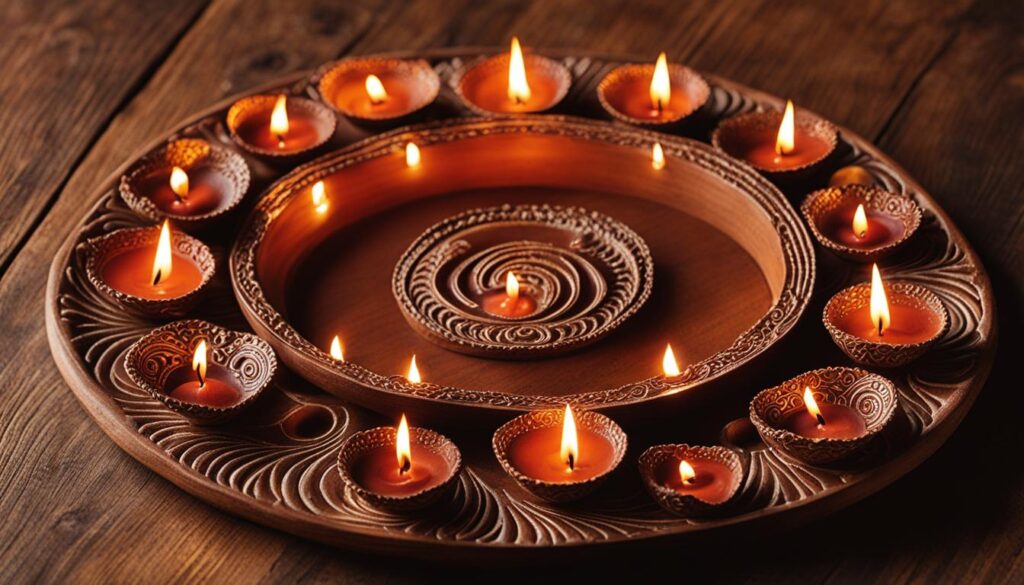
Clay Diya Usage in Different Hindu Traditions
| Hindu Tradition | Clay Diya Usage |
|---|---|
| Vaishnavism | Clay diyas are typically placed in the temple as an offering to Lord Krishna. |
| Shaivism | Clay diyas are used during the performance of religious rituals and ceremonies. |
| Shaktism | Clay diyas are lit to honor Goddess Durga, especially during the festival of Navratri. |
Each Hindu tradition has its own specific rituals and practices related to clay diyas. These variations add diversity and depth to the overall Diwali celebrations, showcasing the rich cultural tapestry of the festival.
Brass Diyas: A Timeless Symbol of Elegance and Tradition
Brass diyas are revered as a timeless symbol of elegance and tradition in Diwali celebrations. Crafted from durable brass, these oil lamps exude a lasting beauty that captivates the senses. With their unique designs and intricate metalwork, brass diyas add a touch of sophistication to the festive ambiance, creating a nostalgic atmosphere that resonates with the richness of Indian culture.
The warm glow emanating from brass diyas evokes a sense of reverence and awe. The flickering flames dance delicately, casting radiant shadows and infusing the surroundings with a tranquil aura. The golden hue of the brass, complemented by the flickering light, creates a mesmerizing visual spectacle that enhances the vibrancy of Diwali celebrations.
Brass diyas are not merely decorative objects; they hold a deeper significance. These traditional oil lamps symbolize purity, enlightenment, and the triumph of good over evil. The act of lighting brass diyas during Diwali is believed to invoke blessings from deities and ancestors, fostering a spiritual connection and inviting positive energy into homes and lives.
| Varieties of Brass Diyas | Description |
|---|---|
| Etched Brass Diyas | These brass diyas are adorned with intricate etchings and patterns, showcasing the meticulous craftsmanship of skilled artisans. |
| Filigree Brass Diyas | These diyas feature delicate filigree work, where thin wires of brass are meticulously twisted and soldered to create intricate designs. |
| Traditional Bell-shaped Diyas | These brass diyas have a traditional bell-shaped design, symbolizing prosperity and abundance. |
| Peacock-inspired Diyas | These diyas are shaped like peacocks, representing beauty, grace, and divinity. |
Brass diyas continue to be cherished as treasured heirlooms passed down through generations. Their allure lies not only in their aesthetic beauty but also in the rich cultural heritage they represent. By incorporating brass diyas into Diwali celebrations, individuals can bask in the timeless elegance and embrace the traditions that have shaped this auspicious festival for centuries.
Embracing the Glow of Brass Diyas
Brass diyas, with their inherent beauty and deep symbolism, are an essential part of Diwali celebrations. From their exquisite designs to the warm radiance they emit, brass diyas create an enchanting atmosphere that envelops homes and hearts. By adorning our surroundings with these traditional oil lamps, we honor the traditions of our ancestors and invite positivity, prosperity, and divine blessings into our lives.
Enhancing Diwali Celebrations with Decorative Oil Lamps
Decorative oil lamps play a significant role in enhancing the beauty and vibrancy of Diwali celebrations. These exquisite lamps, adorned with intricate designs and sometimes embellished with gemstones, add a touch of elegance and luxury to the festive atmosphere. Whether it’s a brass oil lamp that exudes traditional charm or a modern design that incorporates contemporary elements, decorative oil lamps create a visually stunning and memorable Diwali experience.
Oil lamp decorations for festivals can range from ornate brass lamps with delicate metalwork to uniquely decorated clay lamps. These decorative lamps are strategically placed in and around homes and temples, casting a warm and inviting glow that sets the mood for festivities. The soft flickering of the flame, combined with the artistic beauty of the lamp, creates an ambiance that captivates the senses and uplifts the spirit.
Additionally, decorative oil lamps serve as a symbol of light and hope during Diwali. The radiant glow of these lamps represents the triumph of good over evil and the dispelling of darkness. Lighting these lamps not only illuminates the physical space but also kindles the inner spirit, reminding us of the importance of spreading positivity and joy in our lives.
“The soft flickering of the flame, combined with the artistic beauty of the lamp, creates an ambiance that captivates the senses and uplifts the spirit.”
Incorporating decorative oil lamps into Diwali celebrations allows individuals to celebrate the festival in style while honoring the rich cultural traditions associated with the festival of lights. Whether it’s the meticulous craftsmanship of handmade lamps or the eco-friendly nature of clay lamps, these decorative options bring a sense of uniqueness and individuality to each celebration. By choosing decorative oil lamps, individuals can create a visually stunning and enchanting Diwali experience that will be cherished for years to come.
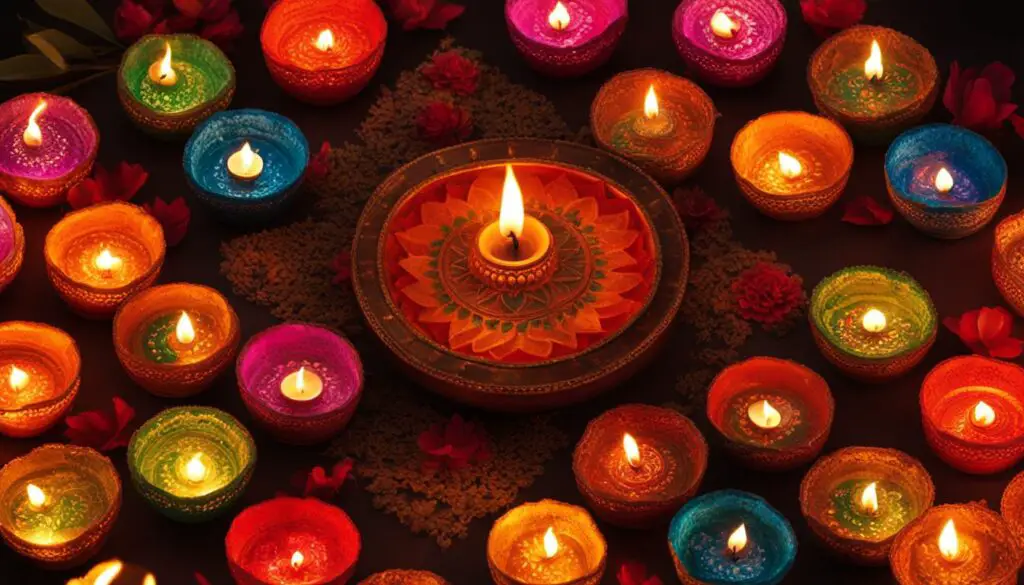
| Lamp Type | Description |
|---|---|
| Brass Oil Lamps | Ornate and traditional, these lamps feature intricate metalwork and are often handcrafted. The warm glow of brass lamps adds a touch of nostalgia and elegance to Diwali celebrations. |
| Handmade Diyas | Crafted by skilled artisans, handmade diyas showcase intricate craftsmanship and artistic flair. These unique lamps add a personal touch and reflect the rich cultural heritage of Diwali. |
| Glass Oil Lamps | Modern and stylish, glass oil lamps come in a variety of shapes and sizes. They often feature contemporary designs and can be adorned with colorful patterns to create a visually striking display. |
| Terracotta Diyas | Simple yet charming, terracotta diyas are crafted from clay and baked to a beautiful reddish-brown color. These eco-friendly lamps are perfect for those who appreciate a rustic and traditional aesthetic. |
Conclusion
Diyas (Oil Lamps) hold a significant place in Diwali celebrations, embodying the spirit of this festival of lights. Their symbolism, cultural traditions, and spiritual significance have been passed down through generations, fostering a sense of unity and reverence.
From traditional clay diyas to decorative brass and handmade options, there is a vast array of choices to enhance the beauty and radiance of Diwali. By embracing the glow of diyas, individuals can experience the magic of this ancient tradition, bringing warmth, positivity, and a sense of divine connection to their celebrations.
As the flickering flame of the diya illuminates the darkness, it serves as a reminder of the triumph of light over darkness and good over evil. Diyas symbolize the invitation of positive energy and the dispelling of negativity, creating an ambiance that guides individuals towards inner wisdom and spiritual enlightenment.
Moreover, diyas hold a special place in sect-specific traditions, with variations in materials, designs, and patterns. While clay diyas embrace tradition and sustainability, brass diyas exude timeless elegance. Over time, diyas have evolved from their humble clay origins to incorporate modern materials and intricate designs, reflecting changing artistic trends.
FAQ
What are diyas?
Diyas, also known as oil lamps, are traditional clay lamps filled with ghee or oil. They hold cultural and spiritual significance in Hindu festivals, particularly Diwali.
What do diyas symbolize?
Diyas symbolize the triumph of light over darkness and the victory of good over evil. Lighting diyas during Diwali represents the dispelling of darkness and the invitation of positive energy into homes and lives.
How are diyas used during Diwali?
Diyas are typically placed at the entrance of homes or in every room during Diwali. They create a warm and inviting ambiance, illuminating the path to inner radiance and symbolizing the pursuit of spiritual enlightenment.
Are there variations in diya designs and usage?
Yes, different sects may have specific preferences for the material, shape, or decoration of their diyas. Brass, clay, terracotta, and decorative glass are among the materials used, and designs may vary based on regional customs and artistic traditions.
What is the significance of handmade diyas?
Handmade diyas showcase the intricate craftsmanship and artistic flair of skilled artisans. They not only serve as functional oil lamps but also act as cultural artifacts, preserving traditional craftsmanship and promoting artisanal skills.
Why are clay diyas considered eco-friendly?
Clay diyas are made from natural clay, making them biodegradable and sustainable choices. They do not harm the environment when disposed of, allowing individuals to embrace tradition while making an eco-conscious choice.
What makes brass diyas special?
Brass diyas are crafted from a durable metal known for its luster and longevity. They add a touch of sophistication to Diwali decorations, showcasing intricate metalwork and unique designs associated with this material.
What role do decorative oil lamps play in Diwali?
Decorative oil lamps add charm and elegance to homes and temples during Diwali. They can be embellished with colorful designs, patterns, or gemstones, enhancing their visual appeal and creating a festive ambiance.
What is the spiritual significance of lighting diyas during Diwali?
Lighting diyas represents the illumination of one’s inner self, the awakening of knowledge, and the dispelling of ignorance. It is a symbolic gesture of inviting positivity, joy, and prosperity into one’s life while seeking blessings from deities and ancestors.
How do decorative oil lamps enhance Diwali celebrations?
Decorative oil lamps, such as designer diyas adorned with gemstones or intricate designs, add a touch of glamour and luxury to the festive atmosphere. They elevate the visual aesthetic and create a visually stunning and memorable Diwali experience.
What keywords summarize the significance of diyas?
Diyas (Oil Lamps), Diwali, cultural traditions, symbolism, spiritual significance


